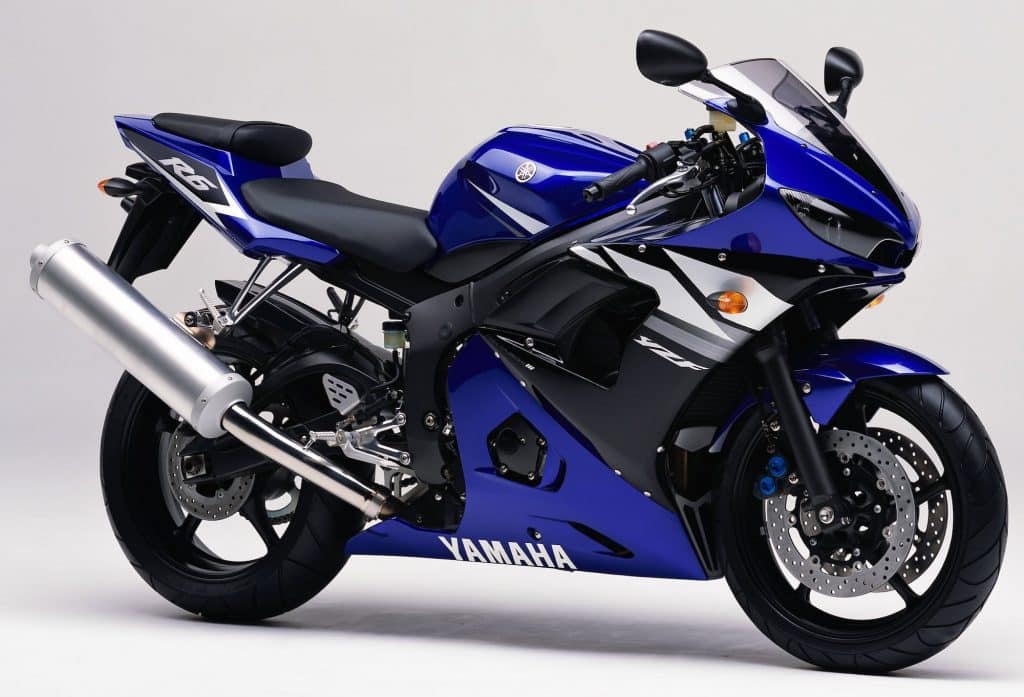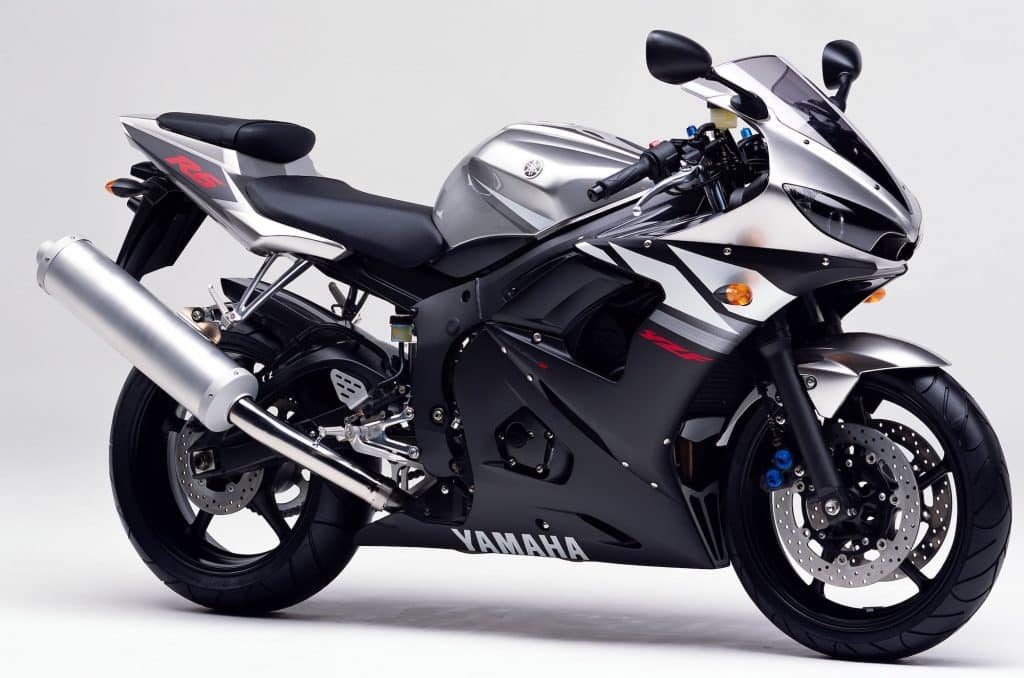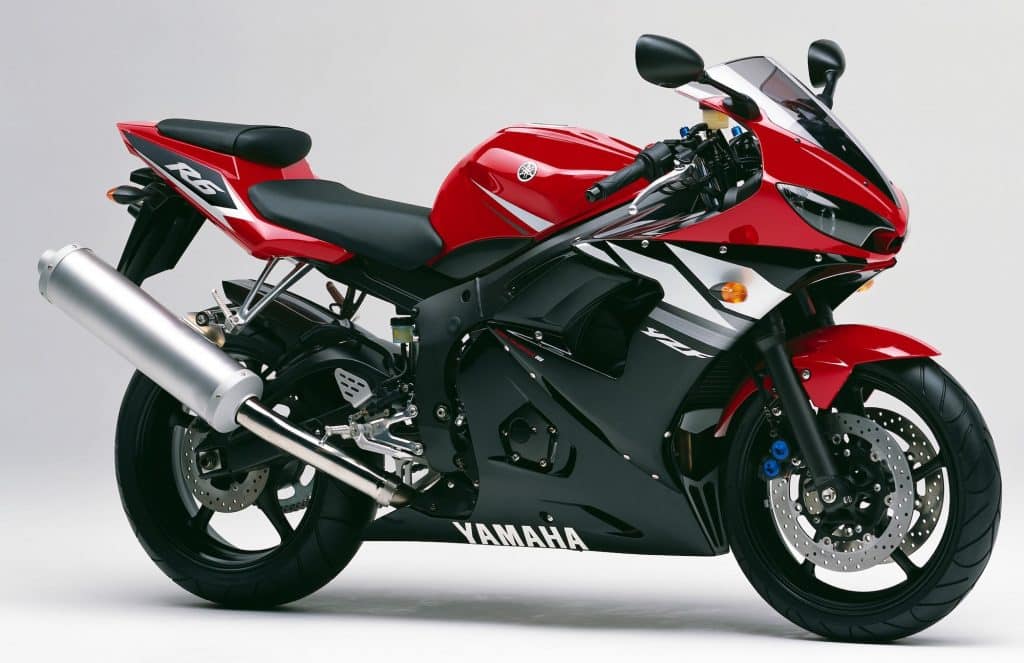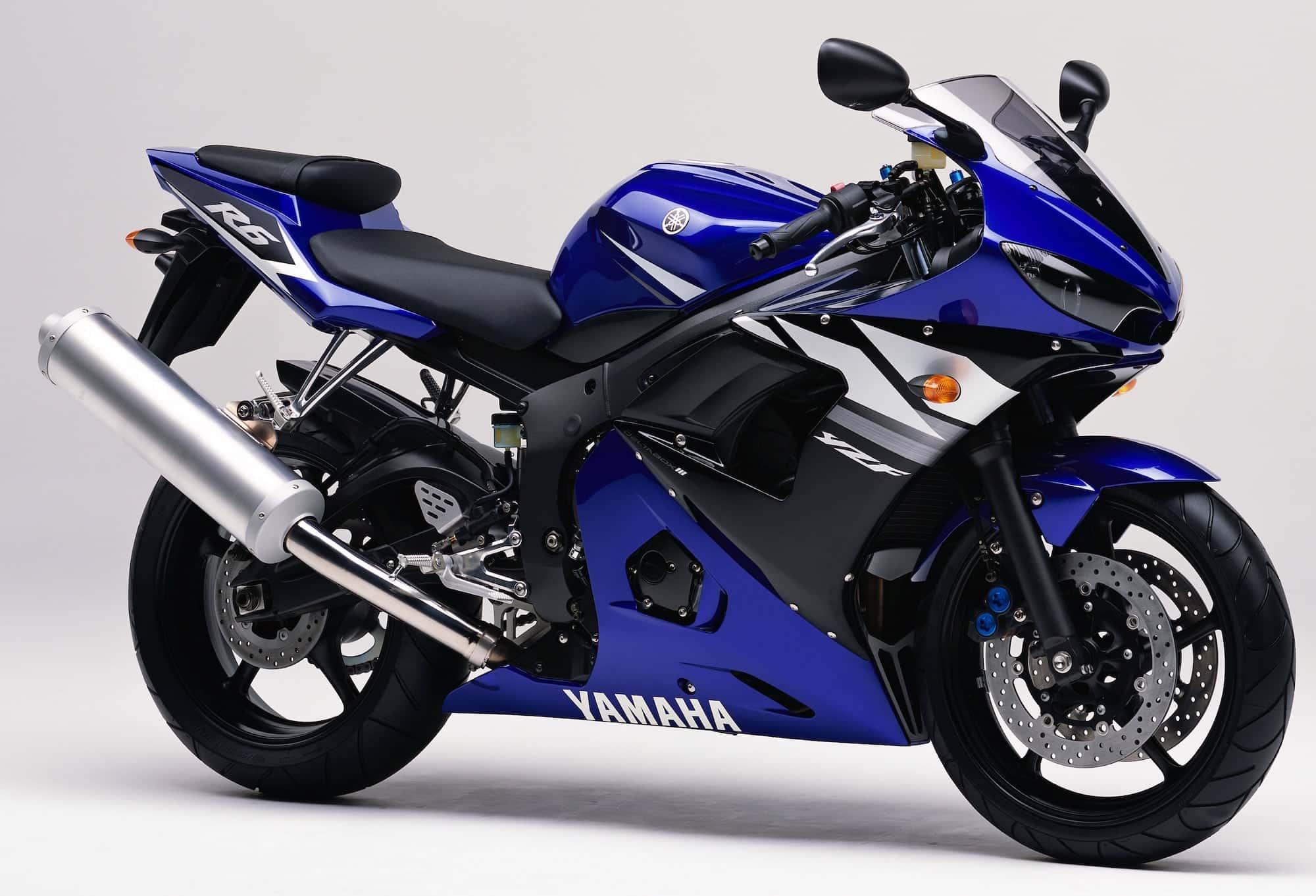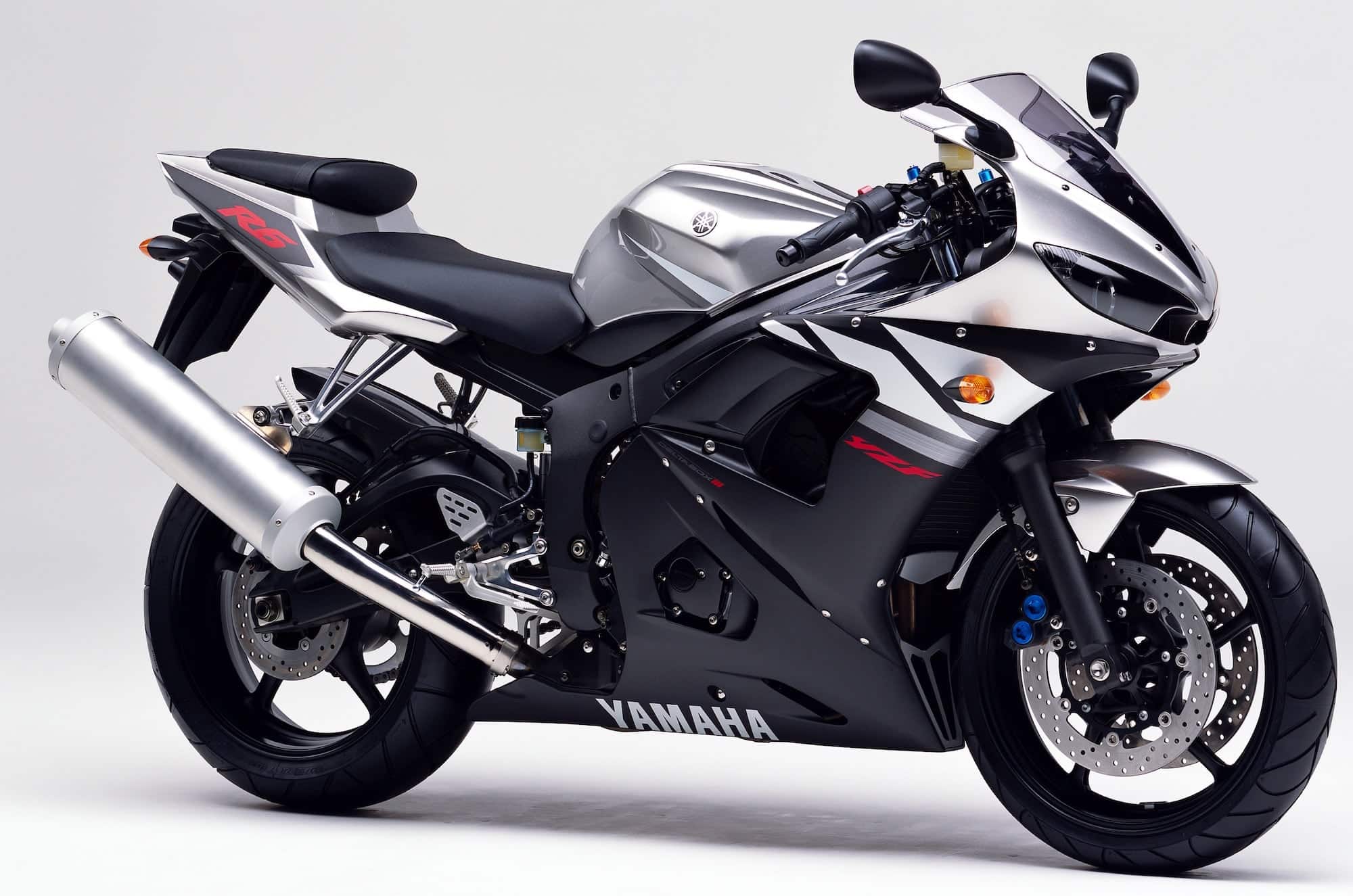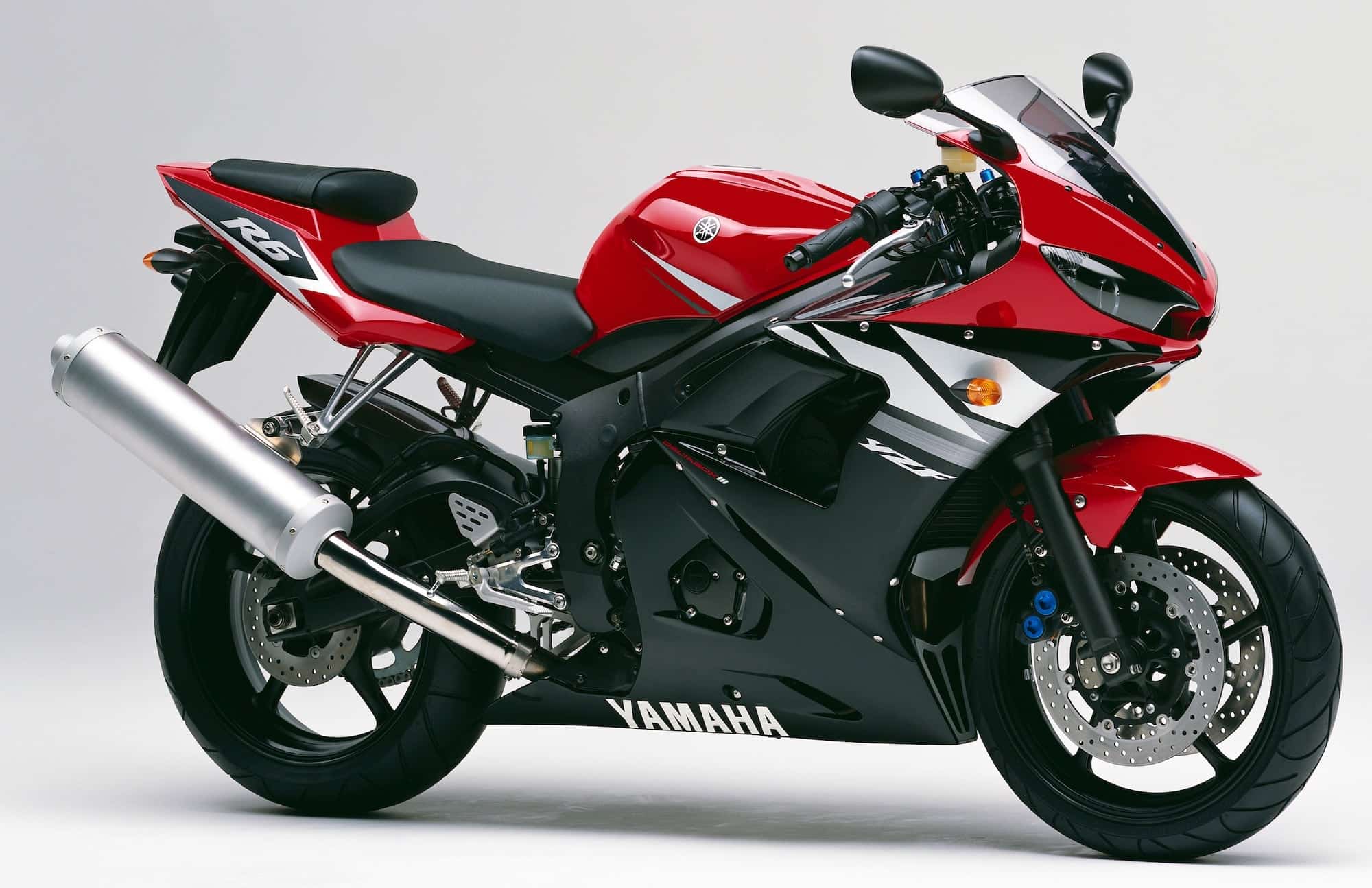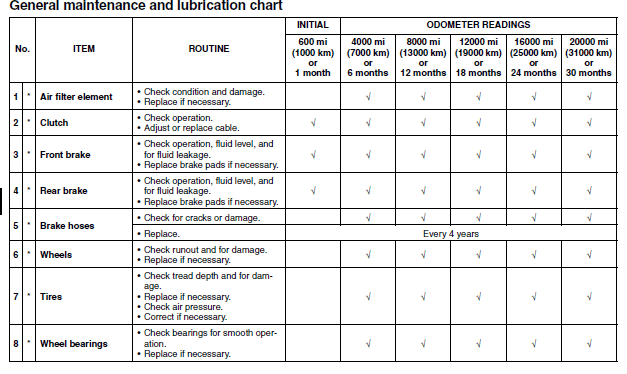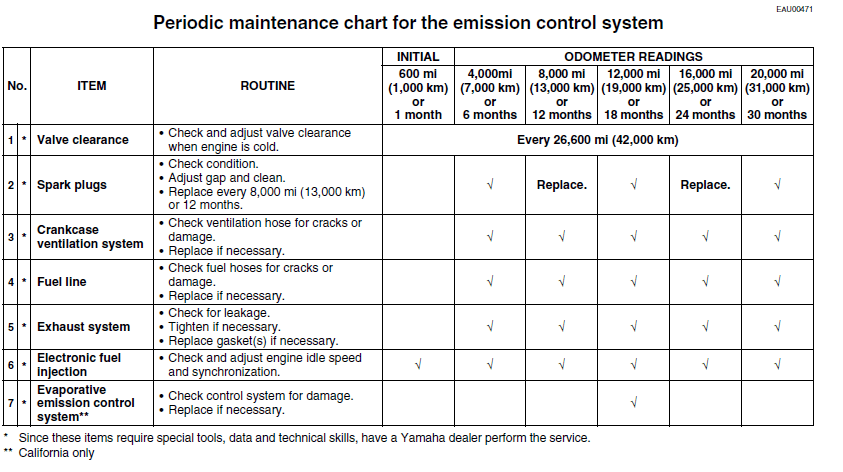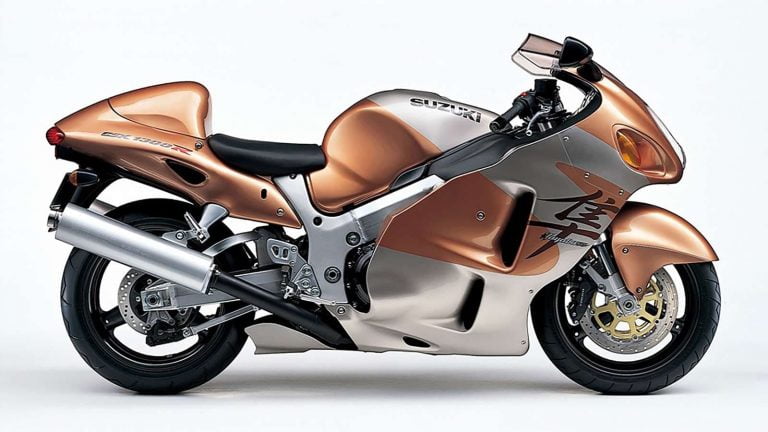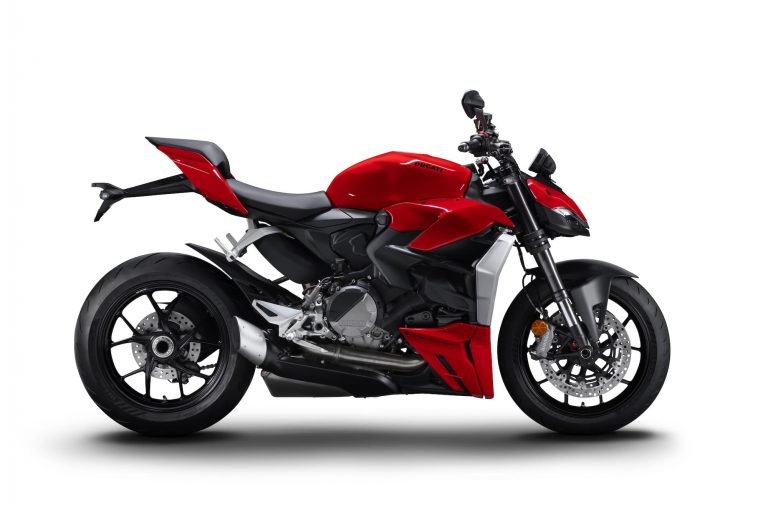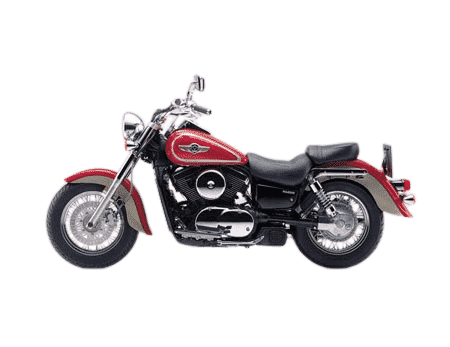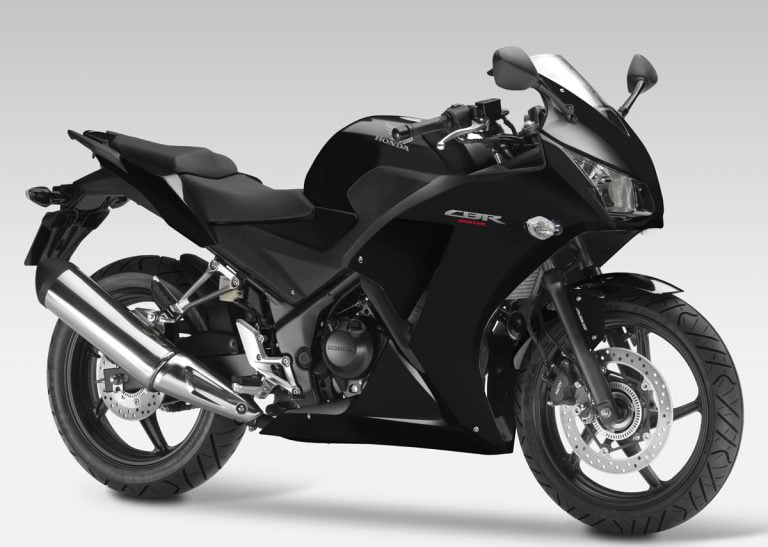Yamaha R6 2nd Gen (YZF-R6, 2003-2004) Maintenance Schedule and Service Intervals
This is the maintenance schedule and associated service intervals for the 2003-2004 Yamaha R6 2nd gen, formally known as the Yamaha YZF-R6.
The 2003 model got fuel injection, and a little later got radial brakes (in 2005, which we consider separately). Like other models in the R6 series, the 2003-2004 Yamaha R6 2nd gen is a track motorcycle that isn’t too compromised for road riding.
The main changes for the 2nd gen model year were the addition of fuel injection and fully-adjustable 43mm conventional forks.
Here are all the generations of Yamaha YZF-R6 for which we have maintenance schedules:
- Yamaha YZF-R6 First Gen (1999-2002) — Carburettor-fed, 65.5 x 44.5mm 599.8cc engine
- Yamaha YZF-R6 2nd gen (2003-2004) — Fuel injected, fully adjustable conventional fork, 298mm discs with axial calipers
- Yamaha YZF-R6 2005 — same fuel-injected engine, but inverted 41mm fork, larger 310mm discs, and radially mounted calipers
- Yamaha YZF-R6 2006-2016 — new more oversquare 67.0×42.5mm 599.4cc engine, YCC-T ride-by-wire, revised gearing, 12.8:1 compression ratio and more power. Received YCC-I in 2008, and a re-tune/higher compression ratio in 2010.
- Yamaha YZF-R6 4th gen — 2017-2020 (final iteration) — ram air, 43mm KYB forks & KYB rear shock, 320mm discs, ABS, traction control, ride modes, visual redesign
The 2005 Yamaha YZF-R6 got some minor updates, but the real updates came with the 3rd Gen Yamaha R6 in 2006.
This post was originally published on July 21, 2020, but has since been considerably updated with more detail.
This site has links for things like oil and spark plugs from which we earn a commission (which unfortunately nobody can save, not even us). If you appreciate this work, then please use those links. Thanks!
Yamaha R6 2nd Gen Maintenance Schedule
Below is the maintenance schedule for the 2003-2004 Yamaha R6 2nd Gen.
Notes on reading this maintenance schedule
- At the end of the maintenance schedule, repeat it in the pattern shown every 1-4 service intervals (or other periods).
- The break-in schedule is not shown (as these bikes are all well broken in)
- Follow the earlier of time-based or the distance-based interval.
| mi x 1000 | 4 | 8 | 12 | 16 | 20 | |
|---|---|---|---|---|---|---|
| km x 1000 | 7 | 13 | 19 | 25 | 31 | |
| Months | 6 | 12 | 18 | 24 | 30 | Every |
| Change engine oil while engine is warm (Yamalube 10W-40) | ✓ | ✓ | ✓ | ✓ | ✓ | |
| Change engine oil filter (HF204RC) | ✓ | ✓ | ||||
| Check air filter condition and damage. Replace if necessary. (YA-6001) Note: Do not clean with compressed air. | ✓ | ✓ | ✓ | ✓ | ✓ | More often if riding in dusty/wet conditions. |
| Check spark plugs. Adjust gap and clean | ✓ | ✓ | ✓ | |||
| Replace spark plugs (NGK CR9EK) | ✓ | ✓ | ||||
| Check and adjust valve clearance | 26600 miles / 42000 km | |||||
| Check cooling system hoses for cracks or damage. Replace if necessary. | ✓ | ✓ | ✓ | ✓ | ✓ | |
| Change coolant (Ethylene glycol-based coolant) | ✓ | 2 years | ||||
| Check front brake operation, fluid level, and for fluid leakage. Replace brake pads if necessary. (FA252HH) | ✓ | ✓ | ✓ | ✓ | ✓ | |
| Check rear brake operation, fluid level, and for fluid leakage. Replace brake pads if necessary. (FA174HH) | ✓ | ✓ | ✓ | ✓ | ✓ | |
| Check brake hoses for cracks or damage. | ✓ | ✓ | ✓ | ✓ | ✓ | |
| Replace brake hoses | 4 years | |||||
| Replace brake fluid (Castrol DOT 4) | 2 years | |||||
| Replace rubber parts of brake master cylinder and calipers | 2 years | |||||
| Check clutch operation. Adjust or replace cable. | ✓ | ✓ | ✓ | ✓ | ✓ | |
| Check throttle operation and free play. * Adjust the throttle cable free play if necessary. * Lubricate the throttle grip housing and cable (Protect All Cable Life) | ✓ | ✓ | ✓ | ✓ | ✓ | |
| Lubricate control cables thoroughly (Protect All Cable Life) | ✓ | ✓ | ✓ | ✓ | ✓ | |
| Check wheel runout and for damage. Replace if necessary. | ✓ | ✓ | ✓ | ✓ | ✓ | |
| Check tire tread depth and for damage. Replace if necessary. | ✓ | ✓ | ✓ | ✓ | ✓ | |
| Check wheel bearings for smooth operation. Replace if necessary. | ✓ | ✓ | ✓ | ✓ | ✓ | |
| Check swingarm bearing assemblies for looseness. Moderately repack (R) with lithium soap-based grease. | ✓ | R | ||||
| Check steering bearing assemblies for looseness. Moderately repack (R) with lithium-soap-based grease as scheduled | ✓ | ✓ | ✓ | R | ✓ | |
| Check all chassis fitting and fasteners. Correct if necessary. | ✓ | ✓ | ✓ | ✓ | ✓ | |
| Lubricate brake and clutch lever pivots with lithium soap-based grease lightly. | ✓ | ✓ | ✓ | ✓ | ✓ | |
| Lubricate brake and shift pedal pivots with lithium soap-based grease lightly. | ✓ | ✓ | ✓ | ✓ | ✓ | |
| Check sidestand operation. Apply lithium-soap-based grease lightly. | ✓ | ✓ | ✓ | ✓ | ✓ | |
| Check sidestand switch operation and replace if necessary. | ✓ | ✓ | ✓ | ✓ | ✓ | |
| Check front fork operation and for oil leakage. Rebuild / replace if necessary. | ✓ | ✓ | ✓ | ✓ | ✓ | |
| Check shock absorber operation and for oil leakage. Replace if necessary. | ✓ | ✓ | ✓ | ✓ | ✓ | |
| Check rear suspension link pivots operation. Correct if necessary. | ✓ | ✓ | ||||
| Check fuel hoses for cracks or damage. Replace if necessary | ✓ | ✓ | ✓ | ✓ | ✓ | |
| Check crankcase breather hose for cracks or damage. Replace if necessary | ✓ | ✓ | ✓ | ✓ | ✓ | |
| Check and adjust engine idle speed and fuel injection synchronization | ✓ | ✓ | ✓ | ✓ | ✓ | |
| Check exhaust for leakage. Tighten up and replace gaskets if necessary. | ✓ | ✓ | ✓ | ✓ | ✓ | |
| Check evap control system for damage. Replace if necessary | ✓ | |||||
| Check the air induction cut valve and reed valve, and hose for damage. Replace any damaged parts. | ✓ | ✓ | ||||
| Check lights and instruments. | ✓ | ✓ | ✓ | ✓ | ✓ | |
| Adjust headlight beam. | ✓ | ✓ | ✓ | ✓ | ✓ |
Maintaining Your Chain on the Yamaha YZF-R6 (2nd gen)
It’s important to maintain your chain on the YZF-R6, as on any chain-driven motorcycle. Use a good-quality chain lubricant like Motul chain paste, or a Motul chain care kit which comes with a couple of handy tools to maintain the chain.
Yamaha recommends you follow the following chain maintenance schedule
- Every 500 mi / 800 km and after washing the motorcycle, OR
- After riding in the rain, or riding in wet areas, or washing the motorcycle.
| Chain maintenance item |
|---|
| Check drive chain lubrication condition, lubricating if necessary (Motul chain paste) |
| Check drive chain slack, alignment, and condition, adjusting / replacing if necessary |
Naturally, if you track or race your YZF-R6, then attend to your chain more often.
Wheel and tire sizes for the 2003-2004 Yamaha YZF-R6
Stock, the 2003-2004 Yamaha YZF-R6 shipped with Michelin Pilot Sport or Dunlop D208 tires. These are street/sport tires.
These days, people are more likely to have fitted more aggressive road / sport tires.
Before 2005, the YZF-R6 wore a slightly odd 120/60 ZR 17 tyre.
| Wheel | Tyre (Tire) size | Tyre (Tire) pressure (cold) |
|---|---|---|
| Front | 120/60 ZR 17 | 250 kPa / 2.5 bar / 36 psi |
| Rear | 180/55 ZR 17 | 250-290 kPa / 2.5-2.9 bar / 36-42 psi |
About the 2003-2004 Yamaha R6 2nd Gen
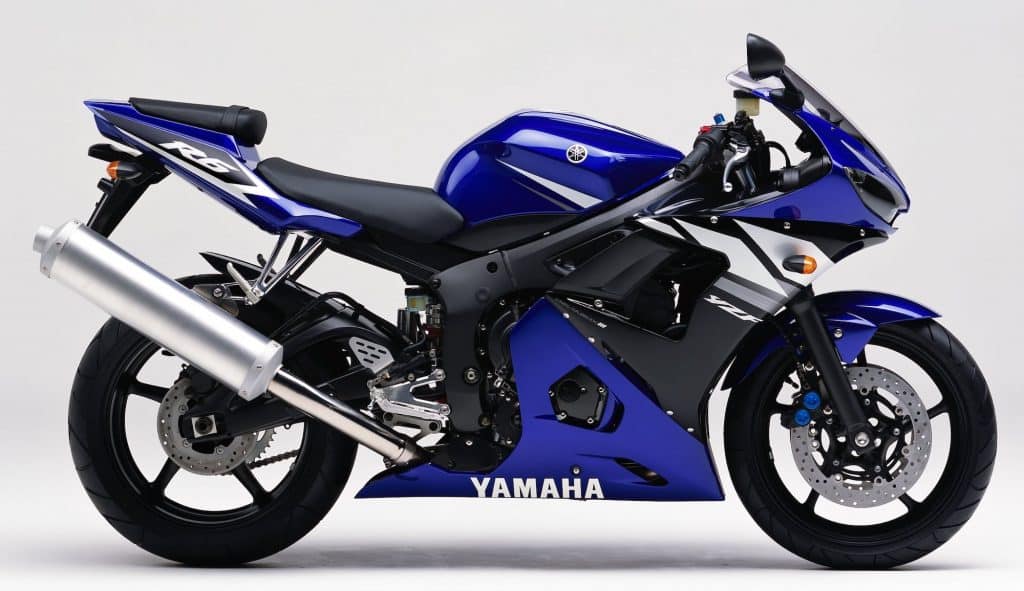
The Yamaha YZF-R6 is a now iconic sportbike from Yamaha, especially as it has been retired from road duty as of 2020. The last generation of Yamaha YZF-R6 was produced between 2017 and 2020.
2003 represented the 2nd generation of the Yamaha YZF-R6. Four years after its introduction, Yamaha introduced fuel injection and fully adjustable forks — though still conventional (not inverted) in design.
The fuel injection system on the 2nd gen YZF-R6 is similar to that used on the 2002 YZF-R1. It’s a “suction pump” hybrid system that’s supposed to mimic the responsiveness of carburettor-fed engines. On the 2003-2004 YZF-R6 the throttle bodies are 38mm in diameter; Yamaha increased this to 40mm and shorter-length intake funnels on the 2005 Yamaha R6.
Naturally along with the introduction of fuel injection, Yamaha made some internal changes to the 2003 Yamaha R6. Yamaha claimed the engine was over 90% new, with changes including
- Stronger and lighter forged pistons (improving over the cast)
- Adjusted cam timing, with higher lift than before (8.2 mm rather than 7.8 mm)
- Sleeveless low-friction cylinders with ceramic-composite bores
However, the bore and stroke of the engine is the same.
The new fuel-injected engine revs to a claimed 15500 rpm.
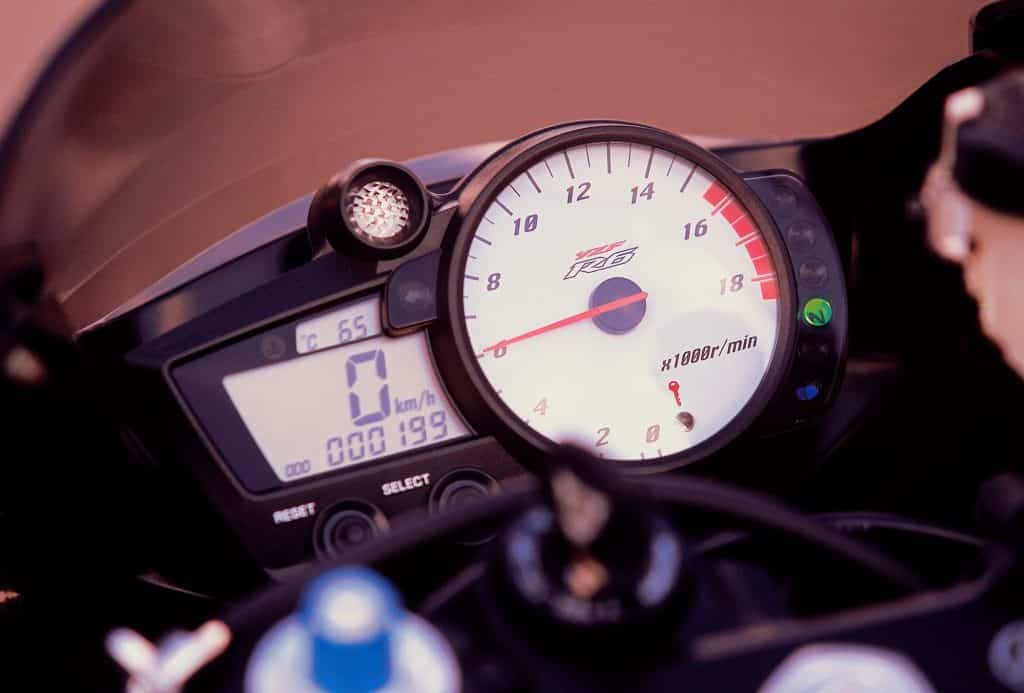
These days, this generation of Yamaha R6 is quite sought after, but low-mileage and well-kept specimens are rare. But the real gem is the 2005 Yamaha R6 with the inverted fork and radial calipers, as well as the more conventional tire size.
Maintenance for this generation of Yamaha YZF-R6 is similar to others but parts are different.
Generally speaking, change the oil every 4000 miles, and change the spark plugs every 2nd service. Every 2-4 years you need to replace fluids (brake fluid, coolant), and every 26600 miles do a valve service.
As with other Yamaha motorcycles, the maintenance schedule for the European manuals is a little different, with 10000 km / 12 month maintenance intervals. And if you race your bike, change your oil more often!
Manual for the 2003-2004 Yamaha YZF-R6
The above information was gleaned from the owner’s manual for the 2004 Yamaha YZF-R6. It’s identical to the previous year.
See screenshots below.
You can download it from Yamaha’s website here.
